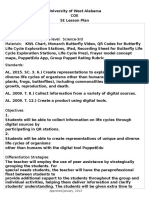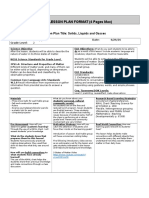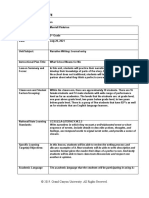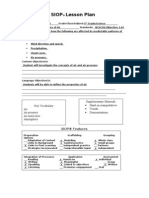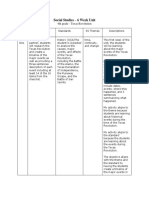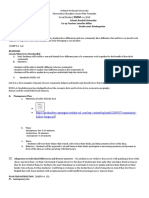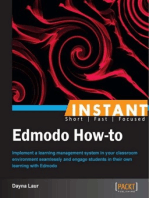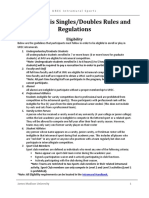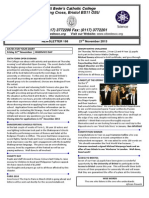Branches of Government Unit Plan Template
Branches of Government Unit Plan Template
Uploaded by
CherylDickCopyright:
Available Formats
Branches of Government Unit Plan Template
Branches of Government Unit Plan Template
Uploaded by
CherylDickCopyright
Available Formats
Share this document
Did you find this document useful?
Is this content inappropriate?
Copyright:
Available Formats
Branches of Government Unit Plan Template
Branches of Government Unit Plan Template
Uploaded by
CherylDickCopyright:
Available Formats
Intel Teach Program
Essentials Course
2011 Intel Corporation. All Rights Reserved. Used by permission. Page 1 of 10
Unit Plan Template
Click on any descriptive text, then type your own.
Unit Author
First and Last Name
Cheryl Dick
School District
Nixa Public Schools
School Name
Helen Mathews Elementary
School City, State
Nixa, MO
Unit Overview
Unit Title
Its a Balancing Act The Three Branches of Government
Unit Summary
Students will research and deepen their understanding about how authorative decisions are made,
enforced, or interpreted within the federal government. Establish a similar system in our classroom.
Students will introduce a bill to solve a classroom problem and work collaboratively to take the bill
through the process working interdependently but relying on one another to complete the process
for a bill becoming a law. They will create an opinion-based multimedia commercial advocating for or
against the bill. The students will be divided into three branches and the proposed bill will have the
opportunity to become a classroom law.
Subject Area
Social Studies
Describe how authoritative decisions are made, enforced, and interpreted within the federal
government.
Identify and explain the functions of the three branches of government in the federal level of
government.
English/Language Arts Write opinion pieces on topics or texts, supporting a point of view with
reasons and information.
Add audio recordings and visual displays to presentations when appropriate to enhance the
development of main ideas or themes.
Grade Level
4
th
Grade
Approximate Time Needed
Fifteen 45-minute class periods
Unit Foundation
Habits of Learning Taxonomy
Blooms:
Comprehension Can you distinguish among the roles of the three branches of government?
Synthesis Can you develop a proposal to support a bill?
Evaluation Can you defend your position? What changes would you recommend?
21
st
Century Skills:
Solve problems Identify and ask significant questions that clarify various points of view and lead to
better solutions.
Intel Teach Program
Essentials Course
2011 Intel Corporation. All Rights Reserved. Used by permission. Page 2 of 10
Targeted Content Standards and Benchmarks
4
th
Grade Missouri Grade-Level Expectations
Social Studies
Strand 5 Principles of Governance Systems
Describe how authoritative decisions are made, enforced, and interpreted within the federal
government.
Identify and explain the functions of the three branches of government in the federal level of
government.
4
th
Grade English/Language Arts Common Core Standard
W.4.1
Write opinion pieces on topics or texts, supporting a point of view with reasons and information.
SL.4.5
Add audio recordings and visual displays to presentations when appropriate to enhance the
development of main ideas or themes
ISTE.NETS*S
3. Research and Information Fluency
Students apply digital tools to gather, evaluate, and use information. Students:
b. locate, analyze, evaluate, and synthesize information from a variety of sources and media.
Student Objectives/Learning Outcomes
Students will locate, analyze, evaluate, and synthesize information about each branch of government
at the federal level.
Students will articulate an opinion that is supported with facts to make a stand of which branch of
government is the most important.
Students will add audio recordings and visual displays to an Animoto presentation to articulate their
opinion and support their opinion with facts.
Curriculum-Framing Questions
Essential
Question
How do we solve problems?
Unit
Questions
How does government affect the lives of citizens?
Why is it important to be an informed voter before going to the polls?
Content
Questions
How do you distinguish among the three branches of government? What does
checks and balances mean?
Assessment Plan
Assessment Timeline
Before project work begins Students work on projects
and complete tasks
After project work is
completed
Intel Teach Program
Essentials Course
2011 Intel Corporation. All Rights Reserved. Used by permission. Page 3 of 10
Anticipation
Guide
Word Splash
Exit Slip
Notetaking
in
Journal/Rubr
ic
Storyboard
Conference/
Rubric
Word Splash
Anticipation
Guide
Rubric for
commercial
presentation
Word Splash
Assessment Summary
Anticipation Guide
*Pre-assessment:
Students write agree or disagree next to statements about the branches of government before the
unit to determine prior knowledge. The teacher will use this information to determine student needs.
Students will use this information for self-direction to help them determine what they need to learn.
*Summative Assessment:
Students write agree or disagree after the statements at the end of the unit to determine content
knowledge. The teacher will use this information to check for understanding and monitor progress.
Students will use this information to demonstrate understanding.
Word Splash
*Pre-assessment
Write these words on the board or SMART board: Legislative Branch, Executive Branch, Judicial
Branch, President, Vice President, Senators, Representatives, Congress, Supreme Court
Allow students two minutes to write what they know about these words. The teacher will use this
information to determine student needs. Students will use this information for self-direction to help
them determine what they need to learn.
*Formative Assessment
Write these words on the board or SMART board: Legislative Branch, Executive Branch, Judicial
Branch, President, Vice President, Senators, Representatives, Congress, Supreme Court
Allow students two minutes to write what they know about these words. The teacher will use this
information to determine student needs. Students will use this information for self-direction to help
them determine how much theyve learned and what they still need to learn.
Exit Slip
*Formative Assessment
The teacher will pose questions that can be taken from the curriculum-framing questions at the end
of class periods to formatively assess student learning that students will answer on exit slips. Only
one question needed per exit slip. Students will also be asked to write questions they have about
the learning. The teacher will use this information to monitor progress, check for understanding, and
adjust instruction as needed. The student will use this to demonstrate understanding and ask
clarification questions as needed.
Notetaking Guide:
*Formative Assessment
Students will take notes in a journal that will be assessed by the notetaking rubric. The teacher and
students will use this information to encourage self-direction and collaboration with peers. The
teacher will also use this information to check for understanding and encourage thinking about the
learning process.
Intel Teach Program
Essentials Course
2011 Intel Corporation. All Rights Reserved. Used by permission. Page 4 of 10
Storyboard Conference:
*Formative Assessment
Students will complete an opinion-based/fact supported storyboard sheet that will be assessed by
the rubric on the sheet. The teacher will hold a conversation with the student to check for
understanding. The teacher and students will use this information to encourage self-direction and
collaboration with peers. The teacher will also use this information to check for understanding and
encourage thinking about the learning process.
Rubric for Commerical:
*Summative Assessment
This will be the final summative assessment. Students will use this assessment to demonstrate
understanding and self-direct their learning. The teacher will use this information to check for
understandng and document learning.
Unit Details
Prerequisite Skills
Students must know the process for a bill becoming a law.
Students must know how to navigate through Internet sites safely using Thing Links or Symbaloo.
Students must be able to use www.animoto.com and know how to embed a video into it.
Students must know how to create a storyboard.
Instructional Procedures
*At the end of each class period, have students reflect about their learning in a notetaking journal. This is a time for
reflection and setting goals. These notes will be assessed by the notetaking rubric. The teacher and students will use this
information to encourage self-direction and collaboration with peers. The teacher will also use this information to check for
understanding and encourage thinking about the learning process.
Days 1-2:
Preassessment:
Pass out the Anticipation Guide (http://www.scribd.com/doc/224123141/Anticipation-Guide-for-
Branches-of-Government) for students to complete. Use this to gather information about students
prior knowledge.
Entry Point:
Write the word problems on the board. Without discussion, brainstorm a list of problems.
Pose essential question: How do we solve problems?
Read The Tired King and discuss these questions from the PDF linked below:
Intel Teach Program
Essentials Course
2011 Intel Corporation. All Rights Reserved. Used by permission. Page 5 of 10
Why was King Louie tired? (He had too many jobs to do.)
Where did King Louies jobs come from? (Letters written by people in his kingdom.)
What jobs did the letters ask King Louie to do? (Make new rules, catch people who
broke the rules, decide what to do with people who break the rules.)
What did King Louie decide to do about his jobs? (Form departments to help him run
his kingdom.)
The Tired King: http://www.westga.edu/~jstrickl/adventures_tired_king.pdf
In this lesson, students are introduced to the three functions of government (legislative,
judicial, and executive) through a story about an overworked king who must handle all the
tasks of government.
Student Generated Questions:
Students work in groups to discuss The Tired King and pose questions the king should consider.
Teacher will spend a few minutes with each group monitoring student progress and providing
feedback to elicit higher-level thinking questions from the students.
Pass out Blooms Taxonomy Question Stems PDF to students:
http://www.meade.k12.sd.us/PASS/Pass%20Adobe%20Files/March%202007/BloomsTaxono
myQuestionStems.pdf. In a whole-group mini-lesson, guide students to look at the questions
theyve written. Using the Blooms Taxonomy PDF, guide students to analyze the level of
thinking required to answer their questions. Give them about ten minutes to generate more
questions.
*Formative Assessment: Exit Slip
Students answer these questions:
How well did you get the information in class? Totally get it, Pretty well, Not at all
What did you learn?
Write one question you came up with.
The teacher will use this information to monitor progress, check for understanding, and adjust
instruction as needed. The student will use this to demonstrate understanding and ask clarification
questions as needed.
Days 3-5:
Pre-assessment: Word Splash
Write these words on the board or SMART board: Legislative Branch, Executive Branch, Judicial
Branch, President, Vice President, Senators, Representatives, Congress, Supreme Court
Allow students two minutes to write what they know about these words. The teacher will use this
information to determine student needs. Students will use this information for self-direction to help
them determine what they need to learn.
Acquire and Internalize Knowledge:
Students will research to gather information about these vocabulary words: legislative branch,
executive branch, judicial branch.
They will fill out a Frayer Graphic Organizer for each word to scafford their learning.
Website to create Frayer Graphic Organizers:
http://www.worksheetworks.com/miscellanea/graphic-organizers/frayer.html
Intel Teach Program
Essentials Course
2011 Intel Corporation. All Rights Reserved. Used by permission. Page 6 of 10
Students will also research to gather information to answer these questions as well as some of their
student-generated questions:
How does government affect the lives of citizens?
Why is it important to be an informed voter before going to the polls?
How do you distinguish among the three branches of government?
What does checks and balances mean?
After reviewing the Frayer Graphic Organzer sheets and research questions, students set daily goals
to determine how much research they plan to complete each day. At the end of each period, groups
meet to discuss research and see if they met their goals. Research should take about a week to
complete.
They will record their notes and daily goal reflection in their social studies journals. Pass out
notetaking guide rubric and discuss expectations with students. Have students set goals to achieve
their desired level of proficiency.
Possible websites for students to use when researching can be found at this Thing Link site:
http://www.thinglink.com/scene/448969801813983233.
*Formative Assessment: Word Splash
Write these words on the board or SMART board: Legislative Branch, Executive Branch, Judicial
Branch, President, Vice President, Senators, Representatives, Congress, Supreme Court
Allow students two minutes to write what they know about these words. The teacher will use this
information to determine student needs. Students will use this information for self-direction to help
them determine how much theyve learned and what they still need to learn. Group students not
demonstrating much understanding into a small group and guide their learning through prompted
questions.
Day 6:
Deepen Understanding:
Groups meet to process research. They will work together to determine similarities and differences
among the branches and organize this information in a Three Venn Diagram.
https://www.teachervision.com/tv/printables/TCR/0743932080_027.pdf
http://www.classroomjr.com/printable-blank-venn-diagrams/
*Formative Assessment: Word Splash
Write these words on the board or SMART board: Legislative Branch, Executive Branch, Judicial
Branch, President, Vice President, Senators, Representatives, Congress, Supreme Court
Allow students two minutes to write what they know about these words. The teacher will use this
information to determine student needs. Students will use this information for self-direction to help
them determine how much theyve learned and what they still need to learn. Group students not
demonstrating much understanding into a small group and guide their learning through prompted
questions.
Days 7-11:
Divide the class into the three branches of government. Youll need a President, Vice President, 4
Senators, about 16 Representatives, and a few Supreme Court justices. Role cards can be found at
Intel Teach Program
Essentials Course
2011 Intel Corporation. All Rights Reserved. Used by permission. Page 7 of 10
this link: http://www.scribd.com/doc/224133799/Branches-of-Government-Role-Cards. Students
must have prior knowledge on how a bill becomes a law. Show Schoolhouse Rock, How a Bill
Becomes a Law, to review: http://www.teachertube.com/viewVideo.php?video_id=144591
Introduce a bill such as:
Students must wear school uniforms.
Recess should be eliminated.
An extra recess should be added to the day.
Brain breaks should be at a set time each day.
Sweets should be allowed in school.
Students will articulate an opinion supported by facts to make a stand for or against the bill. Pass out
opinion rubrics and discuss these with students to help them determine their desired level of
proficiency.
Days 12-15:
Culminating Product:
Students create a commerical in www.animoto.com advocating for or against the bill.
First, students will take the information from their opinion writing piece and turn it into a storyboard.
Discuss the storyboard rubric with students to help them determine their desired level of
proficiency. They need to create pictures, take pictures, or find pictures for each storyboard square.
These will need to be uploaded as JPEG, GIF, or BIP files for Animoto use.
Storyboard: http://www.printablepaper.net/preview/storyboard-letter-3to2-3x3
Storyboard Rubric:
http://rubistar.4teachers.org/index.php?screen=ShowRubric&rubric_id=1127197&
Once the storyboard is approved by the teacher through a student/teacher conference, students may
work with a partner to video themselves highlighting parts of their storyboards. These videos may be
uploaded into their Animoto commericals.
Pass out Commerical Rubric and discuss expectations with students.
Students create their www.animoto.com commericals and share these in class.
Your class should already be divided into the three branches of government. Take this bill through
Congress and have the President sign or veto it. Then, hold a mock trial to let the Supreme Court
determine the fairness of the law, if it passes. If it fails, discuss how the Supreme Court could have
overturned it. Remember, students should have prior knowledge of how a bill becomes a law.
Reflection and Assessment:
Pass out the anticipation guide. Students write agree or disagree after the statements at the end of
the unit to determine content knowledge. Grade these and return to the students. Also, return the
original anticipation guide you used as a preassessment. Have students compare their original
answers to their current answers. Have them reflect on their learning in their notebooks.
Write these words on the board or SMART board: Legislative Branch, Executive Branch, Judicial
Branch, President, Vice President, Senators, Representatives, Congress, Supreme Court
Allow students two minutes to write what they know about these words. Have students compare
their previous quick-writes to this current one and reflect on their learning in their notebooks.
Intel Teach Program
Essentials Course
2011 Intel Corporation. All Rights Reserved. Used by permission. Page 8 of 10
Have students answer these questions in their notebooks:
1.) What did you like about this unit?
2.) If you were the teacher, what would you change for next years students?
3.) How does government affect the lives of citizens?
4.) Why is it important to be an informed voter before going to the polls?
5.) How do you distinguish among the three branches of government?
6.) What does checks and balances mean?
Accommodations for Differentiated Instruction
Special Needs
Students
Provide support for special needs students:
Allow extra time for research and to complete assignments.
Provide a peer tutor or volunteer to assist in research and assignments.
Allow students to tell information in graphic organizers instead of writing
the information.
Allow students to complete anticipation guide orally instead of written.
Provide print copies of items shown on the SMART Board for students.
Highlight important information for them.
Provide partially filled graphic organizers to support students with early
readiness.
Give unit plan to special education teachers so they know whats going
on in the regular classroom.
Allow students with individualized education plans to work with resource
teachers or paraprofessionals.
Nonnative
Speakers
Provide support for nonnative speakers:
Represent what you say with visuals.
Use short, simple sentences with clear articulation.
Include gestures and facial expressions.
Use high-frequency vocabulary (and remember that nouns are better
than pronouns)
Students can draw pictures to represent vocabulary instead of using
words.
Students can make a physical model to represent knowledge.
If you have more than one nonnative speaker, partner them together to
support each other.
If possible, ask for bilingual volunteers to assist students as they learn
the English language.
Source: Classroom Instruction that Works with English Language
Learners (2006), by Jane Hill and Kathleen M. Flynn, ASCD.
Gifted/Talente
d Students
Provide enrichment for gifted and talented students:
Have students create a vocabulary web model instead of the Frayer
organzier. Source: Center for Gifted Education, College of Williams &
Mary, Williamsburg, Virginia. Used with permission in Teaching Gifted
Kids in the Regular Classroom by Susan Winebrenner, page 119.
Have students do a biography study on a politician. Source: Teaching
Gifted Kids in the Regular Classroom by Susan Winnebrenner, pages
100-101.
Materials and Resources Required For Unit
Technology Hardware (Click boxes of all equipment needed)
Camera
Computer(s)
Laser Disk
Printer
VCR
Video Camera
Intel Teach Program
Essentials Course
2011 Intel Corporation. All Rights Reserved. Used by permission. Page 9 of 10
Digital Camera
DVD Player
Internet Connection
Projection System
Scanner
Television
Video Conferencing Equip.
Other
Technology Software (Click boxes of all software needed.)
Database/Spreadsheet
Desktop Publishing
E-mail Software
Encyclopedia on CD-ROM
Image Processing
Internet Web Browser
Multimedia
Web Page Development
Word Processing
Other
Printed Materials
Teaching Gifted Kids in the Regular Classroom (2001), by Susan
Winebrenner, Free Spirit Publishing.
Classroom Instruction that Works with English Language Learners (2006), by
Jane Hill and Kathleen M. Flynn, ASCD.
Showing You: The Show-Me State Booklet:
http://www.house.mo.gov/billtracking/info/showingyou.pdf
PDF of Blooms Taxonomy Question Starters
PDF of Frayer Graphic Organizer
PDF of Venn Diagram
Role cards for Branches of Government
Rubrics
Supplies
Computer
Internet
Paper you can print copies of the rubrics and graphic organizers for
students, but I show mine on the SMARTBoard and let students create their
own. You may want to print these for students with early readiness to
provide support. Students can find these at:
http://www.symbaloo.com/mix/branchesofgovernment3
Internet Resources
Student Internet Resources listed below can be found at:
http://www.symbaloo.com/mix/branchesofgovernment3
Anticipation Guide:
http://www.scribd.com/doc/224123141/Anticipation-Guide-for-Branches-of-
Government
The Tired King Resource:
http://www.westga.edu/~jstrickl/adventures_tired_king.pdf
Blooms Taxonomy Question Stems:
http://www.meade.k12.sd.us/PASS/Pass%20Adobe%20Files/March%20200
7/BloomsTaxonomyQuestionStems.pdf
Schoolhouse Rock How a Bill Becomes a Law:
http://www.teachertube.com/viewVideo.php?video_id=144591
Frayer Graphic Organizer:
http://www.worksheetworks.com/miscellanea/graphic-
organizers/frayer.html
Thing Link for Branches of Government Sites:
http://www.thinglink.com/scene/448969801813983233
Intel Teach Program
Essentials Course
2011 Intel Corporation. All Rights Reserved. Used by permission. Page 10 of 10
Why Three Branches of Government:
http://www.congressforkids.net/Constitution_threebranches.htm
Role Cards for Branches of Government:
http://www.scribd.com/doc/224133799/Branches-of-Government-Role-
Cards
Story Board PDF: http://www.printablepaper.net/preview/storyboard-letter-
3to2-3x3
Rubric for Opinion Writing:
http://www.heinemann.com/shared/onlineresources/E04717/Grade4/Gr4_W
ritePath_LearnProgr_Opinion.pdf
Storyboard Rubric:
http://rubistar.4teachers.org/index.php?screen=ShowRubric&rubric_id=112
7197&
Virtual Field Trips:
http://www.usa.gov/Topics/virtualtours.shtml
http://supremecourt.c-span.org/VirtualTour.aspx
Other Resources
Virtual field trips: http://www.usa.gov/Topics/virtualtours.shtml
Capitol Experience: US Capitol Tour
Library of Congress Tour
Presidential Library Tour
Virtual Field Trip to Supreme Court:
http://supremecourt.c-span.org/VirtualTour.aspx
Contact your local representatives for guest speakers:
http://www.mo.gov/government/legislative-branch/
Programs of the Intel Education Initiative are funded by the Intel Foundation and Intel Corporation.
Copyright 2007, Intel Corporation. All rights reserved. Intel, the Intel logo, Intel Education Initiative, and Intel Teach
Program are ed as the property of others.
You might also like
- Spaghetti and Meatballs For AllDocument3 pagesSpaghetti and Meatballs For Allapi-295655000No ratings yet
- Edtpa Lessons 5-8Document15 pagesEdtpa Lessons 5-8api-282136083No ratings yet
- Reading Lesson On Inferences-Room OneDocument2 pagesReading Lesson On Inferences-Room Oneapi-249813105100% (1)
- Syllabus Montgomery Beginner Adult EslDocument3 pagesSyllabus Montgomery Beginner Adult Eslapi-355425447No ratings yet
- Science Lesson PlanDocument6 pagesScience Lesson Planapi-347975424No ratings yet
- Subject: Central Focus:: Edtpa Lesson Plan TemplateDocument13 pagesSubject: Central Focus:: Edtpa Lesson Plan Templateapi-306956646No ratings yet
- Texas Indians Lesson PlanDocument3 pagesTexas Indians Lesson PlanLaura HiltonNo ratings yet
- LessontwoDocument20 pagesLessontwoapi-351344582No ratings yet
- 2nd A Bad Case of StripesDocument10 pages2nd A Bad Case of Stripesapi-539198127No ratings yet
- Read 3226 Clinical LessonDocument8 pagesRead 3226 Clinical Lessonapi-251731664No ratings yet
- Ty Georges Ell Lesson PlanDocument5 pagesTy Georges Ell Lesson Planapi-283337296No ratings yet
- Water Cycle Lesson Plan - Preslie FleminsDocument4 pagesWater Cycle Lesson Plan - Preslie Fleminsapi-355528708No ratings yet
- Dilly and Dally Duck Lesson PlanDocument4 pagesDilly and Dally Duck Lesson Planapi-312576877No ratings yet
- Neil Thomas - Adair On Communication and Presentation SkillsDocument136 pagesNeil Thomas - Adair On Communication and Presentation SkillsRoman SchwantzerNo ratings yet
- EC2020 Study GuideDocument348 pagesEC2020 Study GuideKalyan_ralla100% (3)
- Aptitude Practice1Document7 pagesAptitude Practice1Awanish Kumar JaiswalNo ratings yet
- Bishop Oconnell-School Profile 2018-19Document4 pagesBishop Oconnell-School Profile 2018-19api-305066699No ratings yet
- Unit Plan Us GovernmentDocument7 pagesUnit Plan Us Governmentapi-277317495No ratings yet
- Main Idea-Its in The Bag Lesson PlanDocument4 pagesMain Idea-Its in The Bag Lesson Planapi-315369018No ratings yet
- Judicial Branch Lesson PlanDocument5 pagesJudicial Branch Lesson Planapi-255764870No ratings yet
- Guided Reading PlanDocument3 pagesGuided Reading Planapi-414140776No ratings yet
- Introduction To The 3 Branches Lesson PlanDocument4 pagesIntroduction To The 3 Branches Lesson Planapi-287301687No ratings yet
- Lesson PlanDocument8 pagesLesson Planapi-440401318No ratings yet
- Edtpa Lesson Plan 2 2Document4 pagesEdtpa Lesson Plan 2 2api-301426398No ratings yet
- 5e Lesson Plan 1Document7 pages5e Lesson Plan 1api-337151712100% (1)
- Lesson Foundation: Title and # Within Unit Grade LevelDocument4 pagesLesson Foundation: Title and # Within Unit Grade Levelapi-344731850No ratings yet
- Diverse Life Cycles 3 Lesson Unit - Lesson 1Document6 pagesDiverse Life Cycles 3 Lesson Unit - Lesson 1api-4084150950% (1)
- Edu2003 Lesson Plan Using The Edtpa Framework Your Name: Allison GerlachDocument4 pagesEdu2003 Lesson Plan Using The Edtpa Framework Your Name: Allison Gerlachapi-456963900No ratings yet
- Sse Final Lesson Plan-DominiqueDocument5 pagesSse Final Lesson Plan-Dominiqueapi-313615727No ratings yet
- Teacher Work Sample Final 2Document55 pagesTeacher Work Sample Final 2api-348361949No ratings yet
- Lesson 3 5Document5 pagesLesson 3 5api-336460917No ratings yet
- Edtpa Lesson Plan 2Document6 pagesEdtpa Lesson Plan 2api-333554671100% (1)
- Legislative Branch Lesson PlanDocument4 pagesLegislative Branch Lesson Planapi-287301687No ratings yet
- 4th Grade NC Symbols Lesson PlanDocument7 pages4th Grade NC Symbols Lesson Planapi-25041716967% (3)
- Edtpa Lesson Plan Format (4 Pages Max)Document5 pagesEdtpa Lesson Plan Format (4 Pages Max)api-28847298No ratings yet
- Math LessonDocument8 pagesMath Lessonapi-464778396No ratings yet
- Udl Lesson Plan 2 1Document4 pagesUdl Lesson Plan 2 1api-657969654No ratings yet
- K-3 Lesson Plan Framework: Cake To Answer Comprehension QuestionsDocument5 pagesK-3 Lesson Plan Framework: Cake To Answer Comprehension Questionsapi-278470419No ratings yet
- Edtpa Lesson PlansDocument12 pagesEdtpa Lesson Plansapi-34049548767% (3)
- MLK Di Lesson PlanDocument8 pagesMLK Di Lesson PlanAndrea MonzonNo ratings yet
- Text Complexity AppleDocument2 pagesText Complexity Appleapi-350961453No ratings yet
- Independent Lesson Plan - Jada GriggsDocument4 pagesIndependent Lesson Plan - Jada Griggsapi-345771743No ratings yet
- Goods and Services Core AssignmentDocument7 pagesGoods and Services Core Assignmentapi-401029139100% (1)
- Unit Plan 1-5Document21 pagesUnit Plan 1-5api-326620154No ratings yet
- Lesson Plan Template: GCU College of EducationDocument6 pagesLesson Plan Template: GCU College of EducationMontell Pinkston100% (1)
- Edtpa Lesson Plan 3Document2 pagesEdtpa Lesson Plan 3api-364684662No ratings yet
- ELD Levels/can Do Descriptors, Etc.) : This Lesson Is Intended For Use in A 9th Grade ELADocument18 pagesELD Levels/can Do Descriptors, Etc.) : This Lesson Is Intended For Use in A 9th Grade ELADanahNo ratings yet
- Edtpa Lessos1-4Document16 pagesEdtpa Lessos1-4api-282136083No ratings yet
- Ecc Prek-2 Lesson Plan AnarchyDocument6 pagesEcc Prek-2 Lesson Plan Anarchyapi-315543674No ratings yet
- Siop - Science Lesson Plan 5th GradeDocument4 pagesSiop - Science Lesson Plan 5th GradeReginald JacksonNo ratings yet
- Communication LessonDocument7 pagesCommunication Lessonapi-278856455No ratings yet
- Direct Instruction Lesson Plan TemplateDocument5 pagesDirect Instruction Lesson Plan Templateapi-282143950No ratings yet
- Lbs 405 5e Lesson Plan RationaleDocument3 pagesLbs 405 5e Lesson Plan Rationaleapi-457177416No ratings yet
- Direct Instruction History Lesson PlanDocument10 pagesDirect Instruction History Lesson Planapi-300194441No ratings yet
- Social Studies - 6 Week Unit: 4th Grade - Texas RevolutionDocument10 pagesSocial Studies - 6 Week Unit: 4th Grade - Texas Revolutionapi-410730922No ratings yet
- 5elesson Plan 1Document12 pages5elesson Plan 1api-458888443No ratings yet
- Monday: Teacher: Week Of: Students: Friday Assessment: Book Title: DRA Level: Take Home Book TitleDocument8 pagesMonday: Teacher: Week Of: Students: Friday Assessment: Book Title: DRA Level: Take Home Book TitleAngela Votaw MillerNo ratings yet
- Kindergarten Science Lesson WormsDocument3 pagesKindergarten Science Lesson Wormsapi-402679147100% (1)
- Fall 2018 Ela Edtpa Lesson Plan 1Document5 pagesFall 2018 Ela Edtpa Lesson Plan 1api-327064630No ratings yet
- Di and UdlDocument2 pagesDi and Udlapi-239009933No ratings yet
- CT 3 Lesson PlanDocument10 pagesCT 3 Lesson Planapi-531622341No ratings yet
- Social Studies 2 Members of A CommunityDocument8 pagesSocial Studies 2 Members of A Communityapi-400451439No ratings yet
- Exemplary Classroom Questioning: Practices to Promote Thinking and LearningFrom EverandExemplary Classroom Questioning: Practices to Promote Thinking and LearningRating: 5 out of 5 stars5/5 (1)
- Progressive Education In Nepal: The Community Is the CurriculumFrom EverandProgressive Education In Nepal: The Community Is the CurriculumNo ratings yet
- Mar 18 2015 PlanboardDocument3 pagesMar 18 2015 PlanboardCherylDickNo ratings yet
- Help! My Entire Class Has ADHD! HandoutDocument56 pagesHelp! My Entire Class Has ADHD! HandoutCherylDickNo ratings yet
- Making 10s Card GameDocument11 pagesMaking 10s Card GameCherylDickNo ratings yet
- Think-Tac-Toe Force and MotionDocument2 pagesThink-Tac-Toe Force and MotionCherylDickNo ratings yet
- Math Anecdotal Record FormDocument4 pagesMath Anecdotal Record FormCherylDickNo ratings yet
- DI Strategies and Activities For Math and ReadingDocument12 pagesDI Strategies and Activities For Math and ReadingCherylDickNo ratings yet
- Mar-16-2015 PlanboardDocument3 pagesMar-16-2015 PlanboardCherylDickNo ratings yet
- Datalicious HandoutDocument9 pagesDatalicious HandoutCherylDickNo ratings yet
- Rubric For GovernmentDocument2 pagesRubric For GovernmentCherylDickNo ratings yet
- 4th Grade News: Helen Mathe Ws ElementaryDocument1 page4th Grade News: Helen Mathe Ws ElementaryCherylDickNo ratings yet
- Rubric For Notetaking GuideDocument1 pageRubric For Notetaking GuideCherylDickNo ratings yet
- Anticipation Guide For Branches of GovernmentDocument1 pageAnticipation Guide For Branches of GovernmentCherylDickNo ratings yet
- Fourth Common Core Math - CodedDocument4 pagesFourth Common Core Math - CodedCherylDickNo ratings yet
- Playground Equipment Catalog: Equipment Picture Price Area NeededDocument4 pagesPlayground Equipment Catalog: Equipment Picture Price Area NeededCherylDickNo ratings yet
- Symmetrical Robot Scoring Guide: Expert 3 Apprentice 2 Novice 1 AreaDocument1 pageSymmetrical Robot Scoring Guide: Expert 3 Apprentice 2 Novice 1 AreaCherylDickNo ratings yet
- Newletter Jan. 28Document1 pageNewletter Jan. 28CherylDickNo ratings yet
- Important Dates: Welcome Ms. Mills!Document1 pageImportant Dates: Welcome Ms. Mills!CherylDickNo ratings yet
- 4th Grade Science COC 2009Document5 pages4th Grade Science COC 2009CherylDickNo ratings yet
- Project-Based Learning K-12.01 HandoutDocument7 pagesProject-Based Learning K-12.01 HandoutCherylDickNo ratings yet
- Uniform Policy Letter 2018-2019Document2 pagesUniform Policy Letter 2018-2019api-368387391100% (1)
- Are You Proud of Your Slogan, Ittoussowecanaddittoourlist.: School Slogan, Motto, & Tagline IdeasDocument6 pagesAre You Proud of Your Slogan, Ittoussowecanaddittoourlist.: School Slogan, Motto, & Tagline IdeasAllieds AcademyNo ratings yet
- Icon DLL EcosystemDocument2 pagesIcon DLL EcosystemCarla Christine Coralde100% (1)
- Lesson Plan 3Document2 pagesLesson Plan 3api-265896050No ratings yet
- Daily Lesson Plan in Oral Communication: Arellano University SY 2020-2021 First SemesterDocument2 pagesDaily Lesson Plan in Oral Communication: Arellano University SY 2020-2021 First SemesterDanica ConcepcionNo ratings yet
- MichDocument51 pagesMichAnonymous 51GSBBNo ratings yet
- Dental Health - Lesson 3Document6 pagesDental Health - Lesson 3api-295860472No ratings yet
- Dissertation Joubert CPDocument117 pagesDissertation Joubert CPKarolJosifMorcillos100% (1)
- Student Evaluation of Teaching: An Instrument and A Development ProcessDocument10 pagesStudent Evaluation of Teaching: An Instrument and A Development ProcessJelita Kasih AdindaNo ratings yet
- NEW DLL 2nd - 2 2018Document3 pagesNEW DLL 2nd - 2 2018Roselyn PinionNo ratings yet
- Vibgyor Formation Story - Contriversial Record of BillabongDocument1 pageVibgyor Formation Story - Contriversial Record of BillabongamitksrivNo ratings yet
- Study Habits and Academic Performance ofDocument40 pagesStudy Habits and Academic Performance ofLennie rose SiribanNo ratings yet
- Department of Education Agbannawag National High School S.Y. 2019-2020Document3 pagesDepartment of Education Agbannawag National High School S.Y. 2019-2020Lingerfaith Mayor MoralesNo ratings yet
- Table Tennis Rules PDFDocument8 pagesTable Tennis Rules PDFshaira alliah de castroNo ratings yet
- Classification of AnimalsDocument6 pagesClassification of Animalsapi-282695651No ratings yet
- Kindness Lesson PlanDocument2 pagesKindness Lesson Planapi-434394234No ratings yet
- Disciplinary Sanctions TeachersDocument1 pageDisciplinary Sanctions TeachersBenjaminNo ratings yet
- Newsletter 168Document2 pagesNewsletter 168St Bede's Catholic CollegeNo ratings yet
- Gerunds Versus Infinitives Exercises Answers-1Document7 pagesGerunds Versus Infinitives Exercises Answers-1Elena Sanvicente PérezNo ratings yet
- Microsoft Office Word DocumentDocument7 pagesMicrosoft Office Word DocumentLilia SerbencoNo ratings yet
- Rene B. Bulakha JR.: Tertiary EducationDocument2 pagesRene B. Bulakha JR.: Tertiary EducationRene BulakhaNo ratings yet
- Module 1 Unit 1Document17 pagesModule 1 Unit 1AJENo ratings yet
- Inglés 7º Básico-Student's BookDocument195 pagesInglés 7º Básico-Student's BookA. P. A.No ratings yet
- Vsu Educ 202 Teacher Interview Form4 Docx 1Document1 pageVsu Educ 202 Teacher Interview Form4 Docx 1api-287301303No ratings yet
























